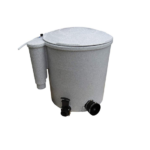At the start of each season, it is important to put into place a comprehensive and effective maintenance plan to ensure that the health of the Koi is maintained as the water starts to warm-up and that there are no unfortunate break-downs of plant and equipment.
For Koi keepers, there is a host of work to be carried out at this time of year in preparation for the warmer weather with increased activity of our Koi and our pond ecosystem. Time spent now will reap large rewards later in the season. The last thing you (or your Koi) want is an equipment breakdown in mid- summer when you are away on your holiday and the neighbour is doing his best to look after your treasured Koi.
Looking at the Pond & Environment now is the time to:
- Clean and vacuum the pond.
- Strip and clean pumps.
- Check all valves and pipework – now is the time to undertake those changes before the heavier feeding starts and the filtration system builds up efficiency.
- Re-direct / re-connect waterfalls which have been bypassed during the cold winter spells.
- Clean and flush the filters – use pond water and clean alternative biological bays at weekly intervals.
- Reinstate any reduced air supplies.
- Replace the UV clarifier tube so its at peak performance when during the summer.
- Test the water – this is most important when the feeding protocol changes (ie increased feeding rate or food type).
- Remember that it will take time for the biological filter to build-up again.
Your Koi
Sit by the pond, have a cup of tea or coffee and just watch the Koi for a while – they will tell you if there is a problem.
- Look for any surface blemishes, marks or changes in behaviour.
- If there are any changes, bowl-up and carefully inspect the Koi – invert and look at the underside of the body and the gills.
- Do not treat the pond as a matter of course.
- If you think you may have a parasite problem, check with a microscope and mucous scrape first. If it’s confirmed, select the best medication to treat the problem, bearing in mind water temperatures.
- Keep an eye on the water temperature and feed accordingly. If temperatures look like dropping again, slow the feeding rate.
Above all, if you have any concerns or problems, do not hesitate to contact us.


